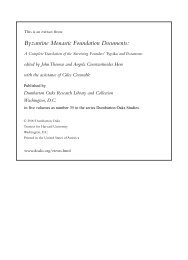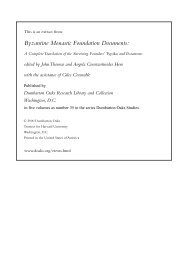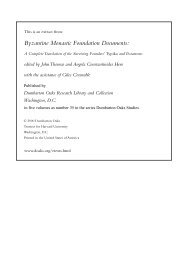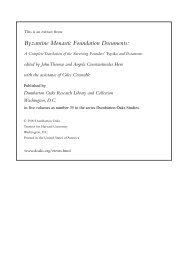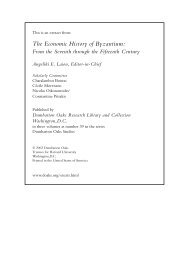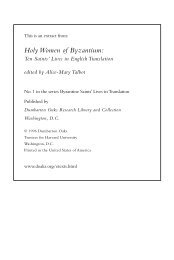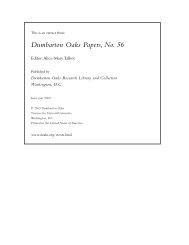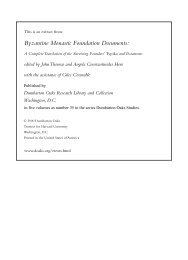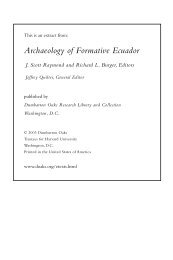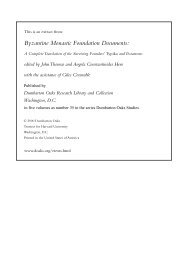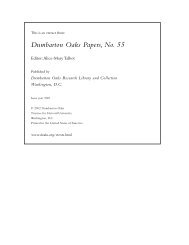Nature and Ideology: Natural Garden Design in ... - Dumbarton Oaks
Nature and Ideology: Natural Garden Design in ... - Dumbarton Oaks
Nature and Ideology: Natural Garden Design in ... - Dumbarton Oaks
Create successful ePaper yourself
Turn your PDF publications into a flip-book with our unique Google optimized e-Paper software.
“TEUTONIC” TRENDS<br />
4. Illustration from Friedrich Ludwig von Sckell’s book Beiträge zur bildenden<br />
Gartenkunst für angehende Gartenkünstler und Gartenliebhaber, Munich, 1818<br />
(photo: <strong>Dumbarton</strong> <strong>Oaks</strong>)<br />
traditions. Beg<strong>in</strong>n<strong>in</strong>g with Roman <strong>in</strong>fluence some two thous<strong>and</strong> years ago, Germanic culture<br />
<strong>and</strong> race s<strong>in</strong>ce then were considered to have been weakened <strong>and</strong> <strong>in</strong>fluenced negatively by foreign<br />
peoples or races. German culture therefore had to go back to those times of alleged racial purity.<br />
Ideas about nature <strong>and</strong> the history of the nation became <strong>in</strong>tertw<strong>in</strong>ed <strong>in</strong> the th<strong>in</strong>k<strong>in</strong>g of the<br />
people who wanted to prove the superiority of the Germanic people. <strong>Nature</strong> <strong>and</strong> history melted<br />
together; the Teutonic people were seen as liv<strong>in</strong>g <strong>in</strong> close harmony with nature.<br />
Related ideas also <strong>in</strong>fluenced garden design. Herder <strong>and</strong> other German <strong>in</strong>tellectuals dissem<strong>in</strong>ated<br />
the idea of an organic unity between l<strong>and</strong>scape <strong>and</strong> German history. In this sense, <strong>in</strong><br />
1818 the garden artist Friedrich Ludwig von Sckell (1750–1823), <strong>in</strong> his famous book Contributions<br />
to an Instructive <strong>Garden</strong> Art for Incipient <strong>Garden</strong> Artists <strong>and</strong> <strong>Garden</strong> Enthusiasts (Beiträge zur<br />
bildenden Gartenkunst für angehende Gartenkünstler und Gartenliebhaber), called for the use of “patriotic<br />
species” of trees <strong>and</strong> shrubs for particular places, 6 “for plant<strong>in</strong>gs of ‘patriotic character,’” for<br />
“simplicity,” <strong>and</strong> for “patriotic pictures” 7 (Fig. 4).<br />
Similarly, Alex<strong>and</strong>er von Humboldt (1769–1859) <strong>in</strong>fluenced later concepts of natural garden<br />
design. In his Ideas for a Physiognomy of Plants (Ideen zu e<strong>in</strong>er Physiognomik der Gewächse),<br />
published <strong>in</strong> 1806, Humboldt referred to “patriotic plant characters” (“vaterländische<br />
Pflanzengestalten”) 8 <strong>and</strong> addressed the decisive impact exercised by the vegetation of a country<br />
on the development of <strong>in</strong>dividual cultures. Accord<strong>in</strong>g to Humboldt, “the knowledge of the<br />
6 Cf. F. L. von Sckell, Beiträge zur bildenden Gartenkunst für angehende Gartenkünstler und Gartenliebhaber, repr<strong>in</strong>t of<br />
2nd ed., 1825, Worms, 1982, 197; see also pp. 130 <strong>and</strong> 226.<br />
7 Cf. Lipp, Natur, Geschichte, Denkmal, 264.<br />
8 A. von Humboldt, Ideen zu e<strong>in</strong>er Physiognomik der Gewächse, Tüb<strong>in</strong>gen, 1806, 14.<br />
191




